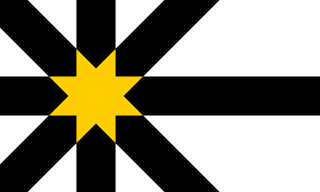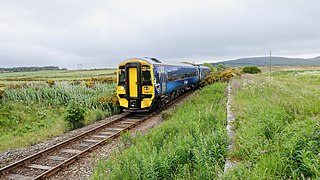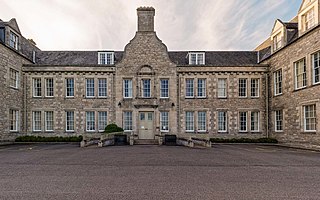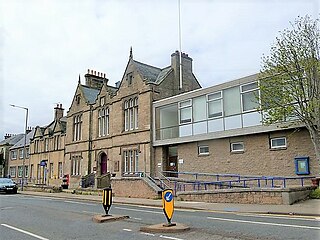
Highland is a council area in the Scottish Highlands and is the largest local government area in the United Kingdom. It was the 7th most populous council area in Scotland at the 2011 census. It shares borders with the council areas of Aberdeenshire, Argyll and Bute, Moray and Perth and Kinross. Their councils, and those of Angus and Stirling, also have areas of the Scottish Highlands within their administrative boundaries.

Sutherland is a historic county, registration county and lieutenancy area in the Highlands of Scotland. Its county town is Dornoch. Sutherland borders Caithness and Moray Firth to the east, Ross-shire and Cromartyshire to the south and the Atlantic to the north and west. Like its southern neighbour Ross-shire, Sutherland has some of the most dramatic scenery in Europe, especially on its western fringe where the mountains meet the sea. These include high sea cliffs and very old mountains composed of Precambrian and Cambrian rocks.

Loch Fleet is a sea loch on the east coast of Scotland, located between Golspie and Dornoch. It forms the estuary of the River Fleet, a small spate river that rises in the hills east of Lairg. The loch was designated a National Nature Reserve (NNR) in 1998, and is managed by a partnership between NatureScot, the Scottish Wildlife Trust (SWT) and Sutherland Estates. The NNR extends to 1058 hectares, including the Loch Fleet tidal basin, sand dunes, shingle ridges and the adjacent pine woods, including Balbair Wood and Ferry Wood. The tidal basin of the loch covers over 630 ha, and forms the largest habitat on the NNR.

Lairg is a village and parish in Sutherland, Scotland. It has a population of 891 and is at the south-eastern end of Loch Shin.

The Far North Line is a rural railway line entirely within the Highland area of Scotland, extending from Inverness to Thurso and Wick. As the name suggests, it is the northernmost railway in the United Kingdom. The line is entirely single-track, with only passing loops at some intermediate stations allowing trains to pass each other. Like other railway lines in the Highlands and northern Lowlands, it is not electrified and all trains are diesel-powered.

Bonar Bridge is a village on the north bank of the Kyle of Sutherland to the west and the Dornoch Firth to the east in the Parish of Creich in the Highland council area of Scotland.

Golspie is a village and parish in Sutherland, Highland, Scotland, which lies on the North Sea coast in the shadow of Ben Bhraggie. It has a population of around 1,350.

Golspie railway station is a railway station serving the village of Golspie in the Highland council area of Scotland. It is on the Far North Line, situated between Rogart and Dunrobin Castle, 84 miles 30 chains (135.8 km) from Inverness. ScotRail, who manage the station, operate all services.

The Bishop of Caithness was the ecclesiastical head of the Diocese of Caithness, one of Scotland's 13 medieval bishoprics. The first referenced bishop of Caithness was Aindréas, a Gael who appears in sources between 1146 and 1151 as bishop. Aindréas spent much if not all of his career outside his see.

Embo is a village in the Highland Council Area in Scotland and the former postal county of Sutherland, about two miles north-northeast of Dornoch.
The Sutherland Railway was a railway company authorised in 1865 to build a line from Bonar Bridge station to Brora, a distance of nearly 33 miles, in the north of Scotland. This was to be continuation of a route from Inverness to Bonar Bridge that had been built by the Inverness and Ross-shire Railway; ultimately the line was extended to Thurso.

The Dornoch Light Railway was a branch railway in Scotland that ran from The Mound on the Far North Line to Dornoch, the county town of Sutherland.
Golspie High School is a secondary school in Golspie, in Sutherland in the north of Scotland.
The Far North Line was built in several stages through sparsely populated and undulating terrain within the Highland area of Scotland. Extending to 161 miles (259 km), it runs north from Inverness to Wick and Thurso in Caithness, and currently carries a regular passenger train service.

Sir William Leslie of Nethermuir (1802–1879) was a Scottish architect and building contractor who served as Lord Provost of Aberdeen 1869 to 1873.

Drummuie, formerly Golspie Technical School, is a municipal structure in Drummuie Terrace, Golspie, Highland, Scotland. The complex, which served as a school from 1903 to 2000 and has been used since 2008 as offices for the Highland Council, is a Category B listed building.

County Buildings is a municipal structure in Newtown Street, Duns, Scottish Borders, Scotland. The complex, which was the headquarters of Berwickshire County Council and was also used as a courthouse, is a Category C listed building.

The Highland Council Headquarters, formerly County Buildings, is a municipal structure in Glenurquhart Road, Inverness, Highland, Scotland. The oldest part of the complex, which currently serves as the headquarters of The Highland Council, is a Category C listed building.

Dornoch Sheriff Court, also known as County Buildings, is a former judicial building on Castle Street in Dornoch in Scotland. The building, which is now used as a restaurant, is a Category B listed building.

















